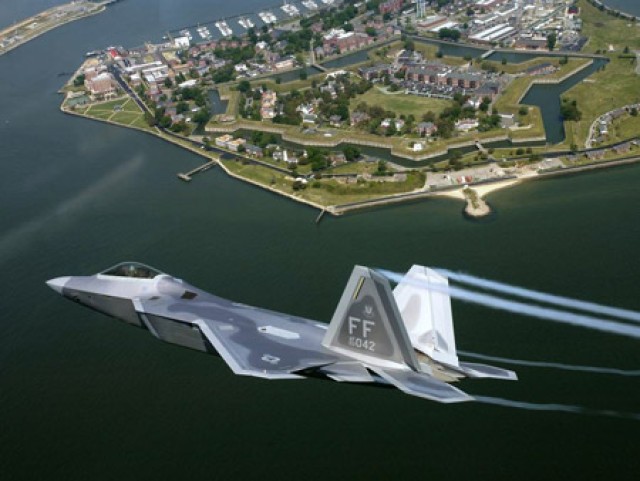FORT MONROE, Va. - Norfolk District has some unfinished business with historic Fort Monroe.
The fort, erected in 1834 at Old Point Comfort in Hampton, Va., will be transferred to the Commonwealth of Virginia on Sept. 15, under the 2005 Base Realignment and Closure legislation. Before then, Norfolk District, U.S. Army Corps of Engineers has work to complete that will benefit the Chesapeake Bay watershed.
Norfolk District is partnering with the Commonwealth's Fort Monroe Authority to design and construct back flow preventers or flap gates for approximately 30 storm drain outfalls located throughout the property. Installation of these tidal check valves will prevent tidal intrusion onto the property and reduce pollutants and nutrients from entering the Chesapeake Bay.
The Water Resources Development Act lays the groundwork for the project and partnership.
"Protection is a big priority at Fort Monroe," said Bill Armbruster, executive director of the FMA. "Parts of Fort Monroe were substantially damaged by floodwaters from Hurricane Isabel in 2003. The Army Corps of Engineers built a new seawall at the post. The completion of this project has a high value to the future success of Fort Monroe at Old Point Comfort."
Fort Monroe is surrounded almost entirely by tidally-influenced waters of the Chesapeake Bay to the east, Hampton Roads harbor to the south, and Mill Creek to the west. Due to its low elevation, the fort is highly susceptible to flooding.
After Hurricane Isabel unfurled its fury on the fort in 2003, Norfolk District proposed the Fort Monroe Flood Proofing project in 2005, as part of a larger flood study of the fort.
Jennifer Armstrong, project manager and biologist at Norfolk District, is leading the flood proofing project. Armstrong recently returned to Norfolk District after serving more than two years with the New Orleans Hurricane Protection Office, where she managed the completion of several key post-Katrina flood protection projects.
"The study found that flooding events on Fort Monroe bring about two significant problems for the Chesapeake Bay," Armstrong said. "First, flood waters infiltrate the sanitary sewer system causing untreated sewage to be discharged into the Chesapeake Bay. The untreated materials contain large quantities of nutrients (phosphorus and nitrogen), suspended solids and fecal bacteria. Second, storm events result in the flooding of basements located on the fort, which can cause a myriad of problems. In the past, this water has been pumped directly into the Chesapeake Bay without treatment. This flood-proofing phase of the project will provide additional defense towards reducing flooding on the fort for up to a 40- to 50-year storm level."
This project alone will not eliminate the threat of flooding caused by tidal surge and tropical storms, Armbruster said, but the Corps also identified additional seawall and breakwater protection projects in their 2005 study which have yet to be implemented.
A $20 million Fort Monroe Seawall Repair and Improvement Project had already begun in the winter of 2003, but it was suspended by the U.S. Army in July 2005, after Fort Monroe appeared on the BRAC list for closure. Secretary of Defense Donald Rumsfeld reauthorized the project in November 2006, and the Norfolk District resumed construction of the seawall repair in March 2007.
Now completed, the new 9.5 foot seawall stands in front of the existing structure, which averaged 7.5 feet in elevation. The seawall project repaired deficiencies and improved flood protection for Fort Monroe from a 5-year level - a storm that has a 20 percent chance of occurring in any given year - to an approximate 25-year level, a storm with a four percent annual occurrence rate. The project included breakwaters and beach replenishment along the lower parts of the shoreline facing the Chesapeake Bay.
Over the years, Norfolk District has partnered with agencies like the Fort Monroe Authority to seek solutions and implement programs for restoring the health of the nation's largest estuary - the Chesapeake Bay.
Stretching across more than 64,000 square miles, the Chesapeake Bay watershed encompasses parts of six states along the U.S. East Coast. With its many tributaries, the Chesapeake Bay watershed endures an array of assaults from the air, water and land. Chemical contaminants, air pollution, landscape changes, erosion and over-harvesting of fish and shellfish also stress the Bay and its wildlife. The watershed's worst problem is nutrient pollution, which fuels the growth of algae blooms that degrade water quality and negatively impact aquatic life.
The Norfolk District has used the Section 510 Program of the Water Resources Development Act to enhance the living resources of the Chesapeake Bay through the reduction of sediment and dissolved nutrients and improvement of wastewater treatment facilities.


Social Sharing